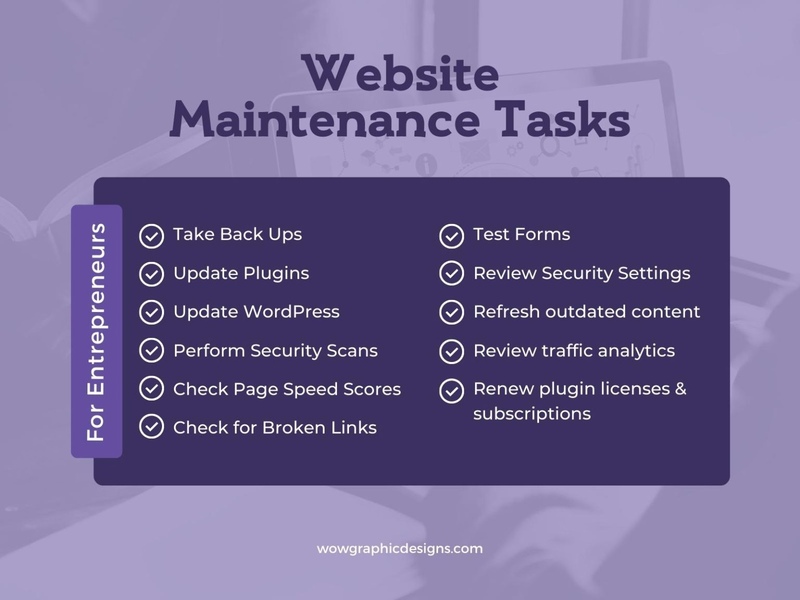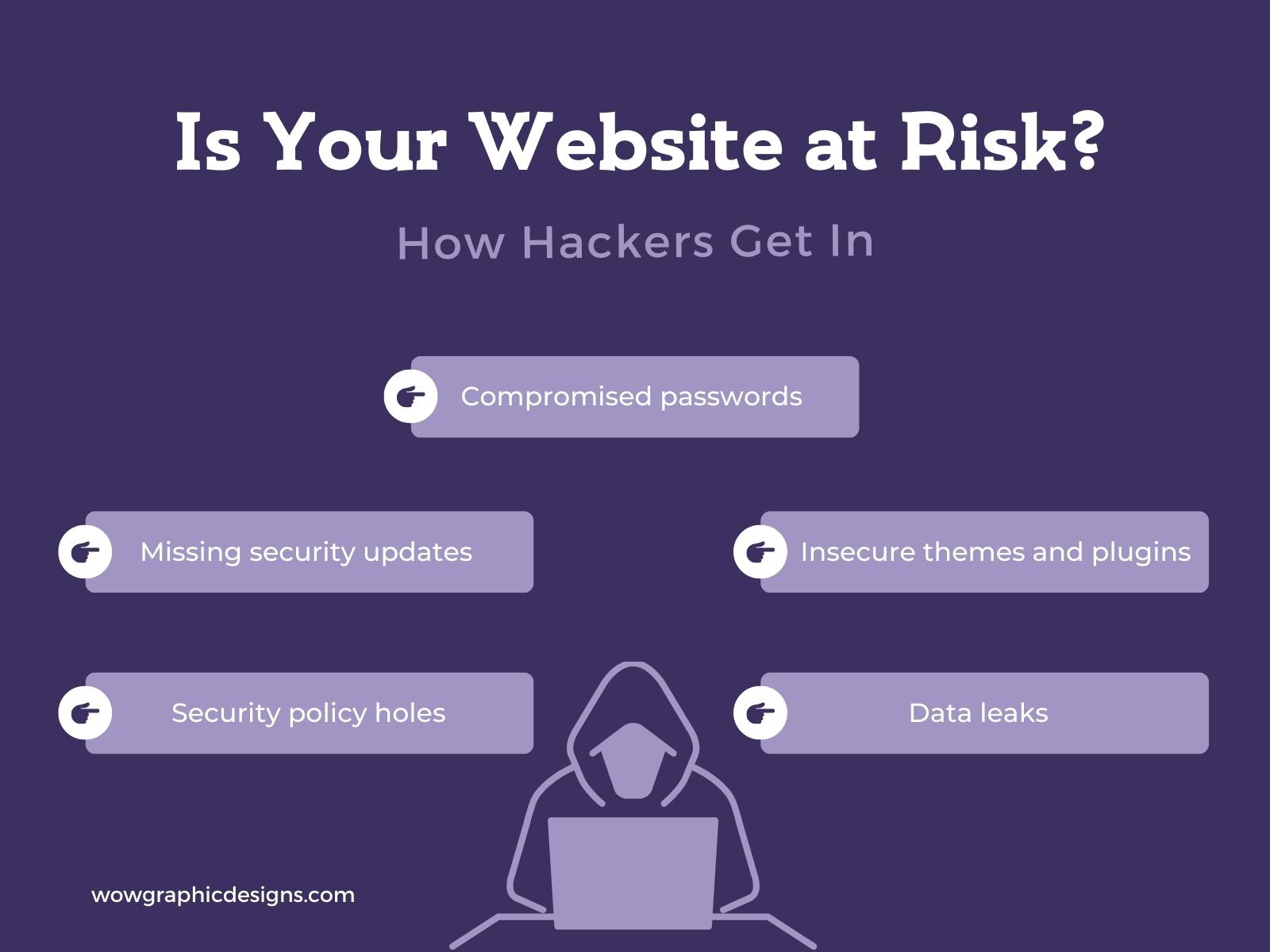As a small business owner, you know that your website is one of your most important marketing tools. But what you may not realize is that your website also needs regular maintenance in order to stay up-to-date and secure.
That’s why we’ve put together this beginner’s guide to website maintenance. In it, we’ll cover why website maintenance is important, how often you should perform it, and what tasks are involved. We’ll also give you some tips on how to make taking care of your website easier.

Why is website maintenance important?
If you’ve ever had a website, you’ve probably experienced the frustration of dealing with a hacked site, a broken plugin, or slow page loading times. These are all common issues that can be prevented with regular website maintenance.
In addition to preventing problems, regular website care can also improve your site’s performance. For example, by keeping your plugins up-to-date, you can ensure that they’re compatible with the latest WordPress updates. This can help reduce the risk of errors and increase your site’s security.
Updating your content regularly is another important part of owning a website. This helps to keep your site accurate and relevant, which can improve your search engine ranking and bring more visitors to your site.
What tasks are involved in website maintenance?
There are a few different tasks that should be performed as part of your monthly website to-do list.

Taking Back Ups
A crucial part of website ownership is taking regular backups. This way, if your website is ever hacked or attacked, you’ll have a copy of your site as it was before the attack. You can either back up your website manually or use a plugin to automate the process.
There are a few different ways that you can take a backup of your WordPress website. However, the most recommended way is to use a plugin like UpdraftPlus. This plugin makes it easy to create backups of your website and store them on your server and in the cloud (e.g. Google Drive, Dropbox, etc.).
You can also manually take a backup of your WordPress files and database:
- Login to your hosting account
- Download all of the WordPress files to your computer.
- Export the WordPress database. You can do this using phpMyAdmin or a similar tool.
- Once you have both the WordPress files and database backed up, you can store them on your own computer or on a remote server.
Updating Plugins
One of the most important things you can do to keep your website secure is to make sure all your plugins are up-to-date. Each time a new plugin update is released, it includes security enhancements and bug fixes. So by keeping your plugins updated, you’ll be able to protect your website against any vulnerabilities that may have been discovered since the last update.
Updating WordPress
If you’re using WordPress, it’s also important to make sure you’re running the latest version. New versions of WordPress are released regularly and usually include security enhancements and bug fixes. So by keeping your WordPress installation up-to-date, you can help protect your website against any potential vulnerabilities.
Performing Security Scans
It’s also a good idea to run regular security scans on your website. These scans will check your website for any known security vulnerabilities and give you a report of any issues that were found. You can either install a security plugin or use an online service to perform these scans.
Checking Page Speed Scores
Another important factor in keeping your website fast and responsive is to check its page speed score on a regular basis. This score will tell you how well your website is performing and what areas need improvement. There are a number of free online tools that you can use to check your page speed score, here’s our favorite:
What makes a website slow?
There are many factors that can contribute to a slow website. One common issue is large file sizes, which can be caused by high-resolution images or videos, excessive scripts, or other elements. Another potential problem is code bloat. This happens when there is too much unnecessary code on a page, which can make the page slower to load.

Another common issue is poor server performance. This can be due to a number of factors, including inadequate resources, traffic spikes, or inefficient code. Improper caching can also lead to slow loading times, as can a lack of compression. Lastly, having too many plugins or scripts can also slow down a website. If your website is slow, try to identify the cause and then take steps to fix it.
Checking for Broken Links
Broken links can lead to 404 errors which can frustrate your visitors and hurt your search engine rankings. There are a number of free online tools that you can use to check for broken links on your website, here’s the three we use the most:
Common links to check include your main menu navigation, social links, text links within blog posts, and external links to outside resources.
Testing Forms
If you have any forms on your website, it’s important to test them regularly to make sure they’re working properly. You can use a plugin or online service to test your forms and find any areas that need improvement.
Reviewing Security Settings
You should also review your security settings to make sure they’re still set the way you want them. over time, as new security threats emerge, you may need to change or update your security settings. By reviewing these settings regularly, you can help keep your website safe from potential attacks.
Refreshing outdated content
If it’s been a while since you launched, it might be time to refresh your website content. You may have outdated information or a dated design that’s no longer relevant. This can be discouraging for potential customers or clients. Instead, take some time to update your site. Add new photos, blog posts, or products. You can also change up the design to give it a fresh look. This will show potential customers that you’re keeping up with the times and that your business is active and relevant.
Reviewing traffic analytics
To check your website traffic, you can use Google Analytics. First, set up an account and then add your website. Once your website is set up, you can start tracking your traffic. Google Analytics will show you how many people are visiting your site, where they’re coming from, and what pages they’re looking at. You can use this information to adjust your website accordingly and make sure that you’re reaching your ideal customers.
Renewing plugin licenses & subscriptions
Some plugins are free, others require premium subscriptions. If your site uses any of these, you’ll have to remember to keep your license active so the plugin continues to work.
- First, log into your website account and go to the plugin section.
- Next, find the subscription you need to renew and click on the Renew button.
- Enter your payment information and click Submit.
- You will then see a confirmation message that your subscription has been renewed.
- Make sure the current license key is set in your plugin settings.
How often should you perform website maintenance?
Ideally, you should perform website maintenance on a monthly basis. This will help you to stay on top of security updates and ensure that your site is running smoothly. If you have a larger website or one with complex features, you may need to perform these tasks more often, such as weekly or even daily.
Make sure you put a reminder in your calendar that automatically repeats so you don’t have to remember to do it!
How can you make website maintenance easier?
One way to make website care easier is to automate some of the tasks.
For smaller websites, you can use a tool like WP-Sweep to clean up your database and remove any unused data. You could set up automatic backups of your site so that you don’t have to remember to do it manually. You can also use a plugin like WPForms to help you manage your forms and prevent them from breaking. For larger websites, you may need to hire a developer to help you set up an automated system.
Either way, automating website tasks can save you a lot of time and hassle in the long run.
How long does website maintenance take?
The time it takes to maintain a website varies depending on the size and complexity of the site. For a small business owner, we recommend setting aside at least an hour per month to update content and keep your site fresh. Larger businesses may need to dedicate an hour per week or more.
How much does website maintenance cost?
The cost of maintaining a website varies depending on the size and complexity of the site, as well as the frequency of updates. However, there are some general guidelines you can follow to estimate the monthly cost of maintaining your website. For a small website, you can expect to spend around $50 per month on hosting and domain fees, as well as any subscription services you use. For a medium-sized website, you can expect to spend around $100 per month on hosting and domain fees, as well as any subscription services you use. For a large website, you can expect to spend around $200 per month on hosting and domain fees, as well as any subscription services you use.
Troubleshooting
What if I break my site?
If your website is down, or you’ve lost important data, never fear! Restoring a website from backup is easier than you think.
If you have a recent backup, you can simply overwrite the existing files on your server. If you have an older backup, you may need to use a tool like phpMyAdmin to import the database. If you’re not sure how to do this, your hosting provider should be able to help you.
What if a hacker breaks my site?
Don’t panic! Take a deep breath and follow these steps:
- Disconnect from the internet and power down your computer.
- Call your hosting company and let them know what happened.
- Restore your website from a backup, if you have one.
- Change all of your passwords, both for your website and for any other accounts that may have been compromised.
- Run a security scan on your computer to make sure there are no viruses or malware present.
- Keep an eye on your credit report for any suspicious activity.
- Last but not least, relax and take a break. You’ve earned it!
How did a hacker break into my site?
If you’re a small business owner, it’s important to be aware of the risks of cyber attacks. Hackers target small businesses because they are usually less prepared than larger businesses to defend themselves. In most cases, hackers gain access to small business websites through weak passwords or by taking advantage of vulnerabilities in the site’s code. Once they’re in, they can steal sensitive data or infect the site with malware. To protect your business, make sure you have strong passwords and keep your website and software up to date.

Why am I getting a 404 error?
If you’re seeing a 404 error on your website, it means that the page you’re trying to reach can’t be found. This can be due to a number of factors, including a mistyped URL, a broken link, or a deleted page.
To prevent losing customers you’ll have to set up a link redirection. This way, if a customer clicks on a link that no longer exists, they will be redirected to another page on your site instead of getting a 404 error.
If you’re sure you’re using the correct URL, try refreshing the page or clearing your browser’s cache. If that doesn’t work, you may need to contact your webmaster for help.
Why are my images not showing up?
If you’re seeing a blank space where an image is supposed to be, it’s likely that the image file is not located in the right directory. Make sure to check the file path and ensure that the image is in the correct location.
Another potential issue is that your image files are too large. Web browsers can only load so much data at once, so if your images are too big, they may not show up. Try reducing the file size of your images by using a program like Photoshop or an online converter like TinyPNG.
Also make sure that you have saved your images in the correct file format. Most web browsers can only display JPEG, PNG, and GIF files. If your image is in another format, you’ll need to convert it to one of these before adding it to your website.
If you’re still having trouble, try refreshing the page or clear your browser’s cache.
Why is there a bunch of random code on my page?
If you’re seeing random code on your website page, it’s likely that your website has been hacked. Don’t worry, though – your hosting provider can help you clean up the mess and secure your site to prevent future attacks.
Why is my website down?
First, take a deep breath! It happens to every website owner at some point. The important thing is to remain calm and follow these steps:
- Check your hosting account to see if your site is actually down, or if it’s just a problem with your domain name.
- If your site is down, contact your hosting provider and let them know. They should be able to help you get your site back up and running quickly.
- If you’re still having trouble, try contacting a website development company like ours. We can help you troubleshoot the problem and get your site back up and running in no time.
What if my domain name expires?
Your website domain name is bound to expire! There are a few things you can do to renew your domain and get your website back up and running. First, check to see if your hosting company offers domain renewal services. If they do, they will usually send you an email reminding you to renew your domain before it expires. Second, you can try to renew your domain yourself by going to the website of the company that registered your domain. Finally, if all else fails, you can always contact a web designer or developer to help you renew your domain and get your website back up and running.
Summary
In conclusion, regular website maintenance is essential for keeping your website running smoothly and preventing problems. By performing website care tasks on a regular basis, you can avoid common issues and keep your site running smoothly.
Daunted by the idea of it all?
Let our team of experts take care of your website maintenance tasks so you can focus on running your business. We’ll handle all the technical details and keep your site running smoothly.

